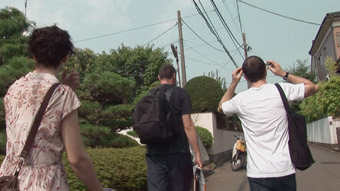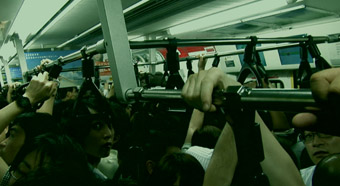tokyo haze
gail priest: kenta mcgrath’s three hams in a can

Three Hams in a Can
THREE HAMS IN A CAN IS AN UNASSUMING FILM ABOUT AN UNEVENTFUL TOUR OF TOKYO BY THREE EXPERIMENTAL MUSICIANS FROM PERTH: CHRIS COBILIS, PREDRAG DELIBASICH AND STINA THOMAS. WE FIRST MEET THEM AS THEY SIT IN SEPARATE ROWS ON THE NIGHT FLIGHT AND THEN FOLLOW THEM, SHAKEY HANDHELD-CAMERA-STYLE, OVER THE NEXT WEEK THROUGH THE STREETS OF MID-SUMMER TOKYO AS THEY SIGHT-SEE, VISIT PEOPLE AND MAKE A LITTLE MUSIC.
Despite being about musicians on tour, the film’s director, Kenta McGrath, chooses not to make their adventures in the experimental music scene his focus, opting for what he argues is a film that is “universal and accessible to those who don’t care less about the music these people were playing” [Director’s Statement]. It is hard not to question the logic. Not to focus on the underground music scene of Tokyo and the artists’ engagement with it is surely to waste a valuable opportunity, and as McGrath does not specifically select another angle, his film teeters on the brink of bland travel doco.
On the other hand, it is the uneventfulness of the film that provides its charm. The three musicians don’t have a lot to say to each other, at least not on camera anyway. But as the film progresses (and a few beers are sunk), we see them open up, particularly in two key scenes which involve interaction with Japanese people. In an extended sequence (which begs serious editing) the gang visit a Japanese family to whom Delibasich, a tall Serbian-Australian, seems somehow related (by marriage one suspects from reading the credits). They are treated to an afternoon of Japanese hospitality, including bbq-ing and playing with a spoiled West Highland Terrier, finishing with the inevitable family photo session. With minimal shared language, the polite strain is evident but so too is a sense of warmth and generosity. The idea of bonding beyond language is driven home in the following scene between a tipsy Delibasich and a sodden Japanese train driver. They sit in a gutter late at night, sharing cans of beer and drunken philosophising, repeating themselves and gesturing goodwill. It’s a moving scene saved from sentimentality by the robustness of the personalities.
At 79 minutes, Three Hams in a Can over extends itself. Perhaps a 50-minute work may have prevented some of the ennui that I experienced watching it (strange given Tokyo is such an exciting city). The hand-held doco style limits the cinematographic palette somewhat, with music performances in clubs filmed from dull angles, or shots of objects blocking vision in tedious ways. And there are simply too many shots following the backs of the musicians as they trudge through the excessive humidity. McGrath’s camera, for the most part is completely passive, lacking a sense of commentary or intention. This may have been an attempt to banish ego, but if so the visual content needed to be more charged to provide greater insights. There are a few moments in which the sequence of events creates its own poetry, such as the walk through the Meji Jingu gardens, where we witness mating butterflies and then a traditional Japanese wedding procession. The final scene where Delibasich and McGrath board a peak hour commuter train, filling beyond capacity, forcing the camera into backpacks and armpits provides one of the film’s more interesting moments.

Three Hams in a Can
In his intention to avoid making a ‘music film’, McGrath missed an opportunity for more innovative use of the artists’ music as his score. The possibilities are glimpsed in a scene of swirling turtles which uses some of Delibasich’s frenetic guitar in parallel with the image, or the sequences with the barking dog and in the packed commuter train where we hear sweet piano pieces by Thomas in intriguing juxtaposition. The concert footage is sometimes informative, showing a range of Japanese artists with styles from rock noise assault to intricate acoustic improvisation. Whether intentional or not, what is revealed about these international gigs, so sought after by Australian musicians in the quest for profile, is that they are quite low-key, humble affairs—just like home. The Australian live set segments are too brief to really show the artists at their best, however the accompanying CD, Smell You Later, with five tracks each from the artists, demonstrates their work to better effect.
Co-incidentally, I was in Tokyo in August 2008 when the film was shot, so I was filled with nostalgia, seeing the gang wander the streets past the same mysterious posters, mopping sweat, marvelling at the swarming turtles and hearing the screaming semi (cicadas). Perhaps the strength of the film is its authenticity and its avoidance of ‘Lost in Translation’ clichés. I wonder if its understated charm is as universal for those who have not been to Tokyo in mid-summer. Three Hams in a Can is an interesting film, just one that I wished had explored its subjects and its form more thoroughly.
Three Hams in a Can, director Kenta McGrath, featuring Chris Cobilis, Predrag Delibasich, Stina Thomas, Little Boy Pictures/Heartless Robot Productions; www.threehamsinacan.com
Three Hams in a Can premiered at the 2009 Revelation Film Festival
RealTime issue #93 Oct-Nov 2009 pg. 22






